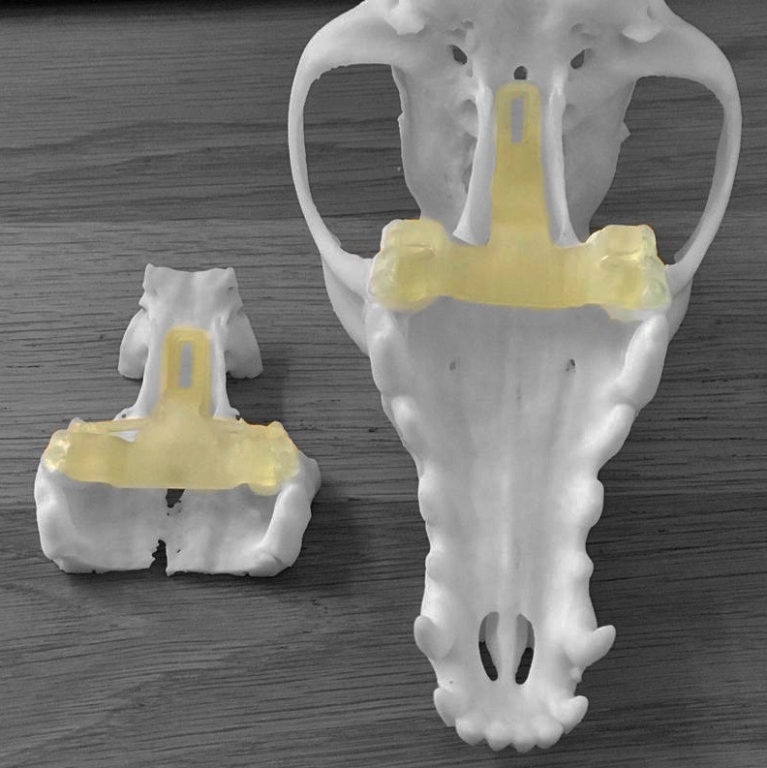
The anotomical placement of the 3D printed guide
Pioneering 3D Printed Guide To Aid Pituitary Surgery In Dogs With Cushing’s Disease
New approach developed by CVS neurologists, funded by CVS Research Award, will help vets to offer the best clinical care
A new approach to improve surgery for dogs with Cushing’s disease has been developed through research led by neurology clinicians (Drs Nicolas Granger and Leticia Escauriaza) at CVS’ Highcroft Veterinary Referrals and funded by a CVS Clinical Research Award.
The team at Highcroft worked to develop and assess the design of a 3D printed guide to enable safer brain surgery for a challenging procedure in dogs with Cushing’s disease.
Cushing’s disease is a common endocrine disease in ageing dogs that results in high levels of cortisol in the blood. Most frequently, this is due to a mass within the pituitary gland secreting cortisol. Certain medication can reduce the levels of cortisol and manage the associated clinical signs, but these are only palliative. With transsphenoidal hypophysectomy surgery, the pituitary mass is removed and this offers a cure. However, this advanced surgery is challenging because of the deep location of the pituitary gland underneath the brain. The region is accessed through the mouth but this is hard to locate and contains many important blood vessels that the surgeon needs to avoid. Precision is therefore at the essence of this surgery.
This study explored whether a 3D printed surgical guide, placed in the dog’s mouth, could aid specialist neurosurgeons in locating the correct site of the pituitary with good accuracy. The team found that it was possible to create a 3D printed guide from CT images, and that it can be used by surgeons to accurately identify the exact location of the body cavity containing the pituitary gland. The final design, developed with collaborators at Vet3D[i], Dr Bill Oxley, is a guide that locks on the dog’s molar teeth and is bespoke to each patient, based on their CT images. It will enable veterinary neurosurgeons to offer the best clinical care every time.
Hypophysectomy is an effective treatment option for dogs with Cushing’s, if due to a pituitary tumour. By removing the abnormal pituitary gland, the signs of the disease quickly subside and the long-term outcomes are favourable. Recent data shows that long term survival is far greater for dogs receiving surgery compared to those treated with medication. The new research offers a way to support surgeons undertaking this surgery more safely and could also help specialist veterinary neurosurgeons wishing to be trained to perform hypophysectomy, making this surgery more accessible to companion animals in the long run.
Nicolas Granger, European and RCVS Specialist in Veterinary Neurology (Small Animals) at Highcroft Referrals and lead author, said:
“The 3D printed surgical guide research lends itself well to being performed in clinical practice. Only a few specialist UK centres offer hypophysectomy which can be used for Cushing’s disease in dogs and acromegaly in cats. At Highcroft, we commonly see dogs and cats affected by pituitary conditions and have been offering this surgery for some time.
“Testing the 3D printed guide was natural for us as it did not distract from performing the surgery, but allowed us to add another safety layer for our patients. We know that our 3D printed guide is useful to locate the exact entry point into the bony cavity containing the pituitary gland.
“Practically, we are now able to provide advice on the surgical indication from CT images of the patient. If a dog or cat is dimed a potential candidate, we will collaborate with Vet3D to design and print the guide from the CT images in a timely manner - usually within a few days. We can then assist with the surgery.
“We would now like to make this surgery more accessible to colleague neurosurgeons and to further assess whether this tool can help when teaching the procedure.”
CVS Clinical Research Awards were launched in January 2022 and are an industry first; offering funding for research undertaken by its employees and research undertaken by universities. The awards support clinical veterinary research which has a direct clinical benefit to animals and which will impact upon veterinary practice. The A 3-Dimensional Printed Patient-Specific Surgical Guide to Facilitate Transsphenoidal Hypophysectomy in Dogs study, published in the Frontiers in Veterinary Science journal, is one of 16 projects CVS has funded since its awards were launched.
To learn more about the CVS Clinical Research Awards, and how to apply, please visit www.cvsukltd.co.uk/research-awards. To read more about CVS’s sustainability strategy and ongoing One Health Workstreams,www.cvsukltd.co.uk/wp-content/uploads/2022/08/CVS-Group-plc-Sustainability-Report-2022 .
CVS Group operates across small animal, farm animal, equine, laboratories and crematoria, with over 500 veterinary practices, referral centres and sites in the UK, the Republic of Ireland and the Netherlands. In the last five years the company has invested nearly £80 million in its sites, facilities and equipment, in addition to industry leading training and support, to give the best possible care to animals.
More from CVS UK Ltd
- Precise imaging and unconventional fixation resolve challenging tarsal fracture
- CVS Farm Vets launches innovative Sheep Lameness Project to support UK farmers
- New 'CVS Vets' brand is launched at Broadleaf
- New study reveals key prognostic indicators in canine mast cell tumours
- Ernie’s ball trouble: Managing a challenging oesophageal foreign body

 3 years ago
3 years ago  766 views
766 views